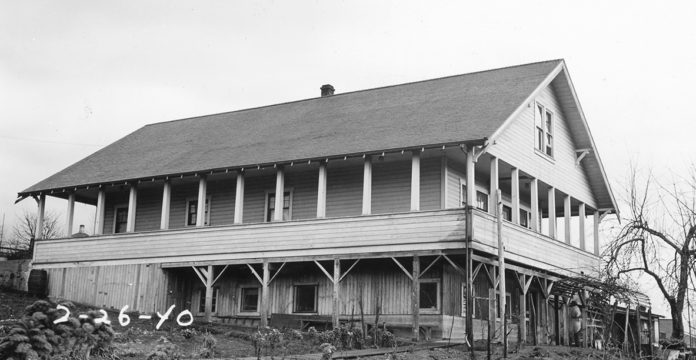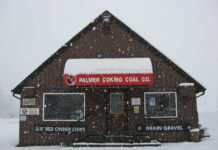A home is more than just a house. It sometimes reflects the life of the one who built it. This Black Diamond home with its enormous front porch is very much the story of Aniceto Magnani and Ermellina, the widowed wife he left behind.
Magnani was born in 1885 in Sillano within the Tuscany region of Italy. Like many young men of the era, the 21-year-old Aniceto emigrated through Ellis Island in 1907. Traveling from Le Havre, France, he landed with $20 in his pocket. Magnani was bound for Ohio, but immigration officials detained him because he didn’t have a pre-paid ticket to his final destination. There he’d join a friend, Acouchi Evaristo. A telegram was sent, and a ticket secured, with Magnani released the next day to board a train and begin his new life in America.
A decade later in 1918, Aniceto was living in Black Diamond as a boarder in the home of fellow Italians, Louie and Mary Stella. Magnani worked as a coal miner for Pacific Coast Coal Company, which at the time was operating the deepest underground coal mine in the United States. By 1921, he was a motorman operating electric locomotives that hauled coal cars throughout the mine.
In early January 1925, Magnini married Ermellina Marietta (Crudeli) Rossi, divorced from her first husband, Frank Rossi and gained five stepchildren in the process: Olivia Maria Rossi, the eldest who was already married to Nello Merlini; Emil Flaminio Rossi who would later marry Alice Flothe, then Ila, then Harriet Manowski; Hortense Clara Rossi, aka Artie who married Donald Sackmaster, and two others; Albert Rossi who would marry Beatrice May Grady; and Harry Mareno Rossi who would marry Genevieve Manowski. At the time of their marriage, Ermalina’s youngest four were still children.
Three months later this note was entered on Magnini’s 3×5 index card on which Pacific Coast kept detailed records on their employees – “arrested for bootlegging on March 14, 1925.” During Prohibition, many Italians in Black Diamond and elsewhere continued the traditions of their ancestors by making wines and spirits for home use and sale to others.
According to a Seattle Times headline from March 7, 1927, Aniceto Magnani “Put ‘Life’ Into A Party,” after Magnani crashed a gathering in Black Diamond at the home of Nello and Olive Merlini, his stepdaughter-in-law. Magnani apparently grew hostile “when informed his presence was not urgently required.” The plaintiffs, Nello and Olivia Merlini together with friends, Achilles and Mary Viovi filed suit against Magnani for $30,300 in damages after “the unwelcome guest with a revolver in one hand and a blackjack in the other proceeded to ‘beat up’ the hostess and another woman guest.” Blackjack was then a colloquial name for a wooden baton used by law enforcement. Surprisingly, this questionable behavior was not written down on Magnini’s ‘permanent record’ – the coal company’s 3×5 index cards.
The results of the legal action, if any, are not known. Yet, whether from bootlegging profits or hard work as a miner, by 1927, Aniceto Magnani saved enough money, $438, to purchase 2.5 acres of vacant land from his employer Pacific Coast Coal. With the end of World War I and a subsequent decline in coal production, Pacific Coast, as owner of the company town began selling off small lots, often to their employees. Magnani’s site was just below Railroad Avenue in an area where a number of Italians lived. There he built this 2,400 square foot house in an era when most miner’s cottages were modest dwellings, typically less than 1,000 square feet. His large structure likely housed not only Magnani’s wife, Ermalina and stepchildren but sometimes fellow Italian coal miners and who stayed as short-term boarders. Two of Ermalina’s great-grandchildren considered her to be “a mean, vengeful woman” or “a toxic individual” with “a vile personality.” This Feb. 22, 1940 photo of tax parcel 142106-9045 comes courtesy of the Puget Sound Regional Archives collection of King County Assessor records.
Ancieto Magnani’s story has a tragic ending. In August 1931, he left Pacific Coast Coal where he worked as a contract miner at their New Black Diamond Mine. He started work for Jim Bolde’s Carbon Fuel Company mine in Bayne, near Cumberland. Two years later he suffered a fractured skull from a rock fall on Sept. 28, 1933, and died the following day at Seattle’s Providence Hospital. His widow, Ermellina remained in their home and by 1940 had one boarder, Dominico Agari, who she later married. The home was located next door to her daughter, Olivia, and son-in-law, Nello Merlini, plus their four children; Ermellina’s brother, Ermete (Emmett) Creduli; and her first husband, Frank Rossi.
As for this house, it still stands at 25203 Merino Street about 100 yards southwest of the Black Diamond Bakery. Since 1998, the home has been owned by George and Heidi (Holling) Sato. Genealogical information for this article was provided by Donna Brathovde, a Ravensdale researcher with additional information from JoAnne Matsumura, an Issaquah historian. Doug “Boomer” Burnham, a Tahoma High School teacher who operates www.BoomersPhotography.com provided photo enhancements.







